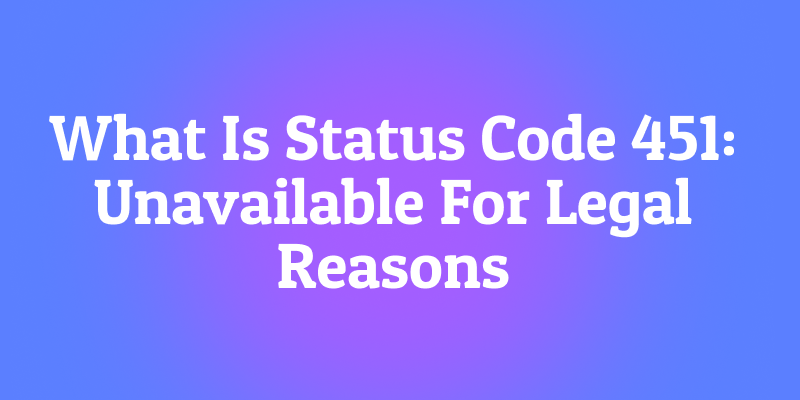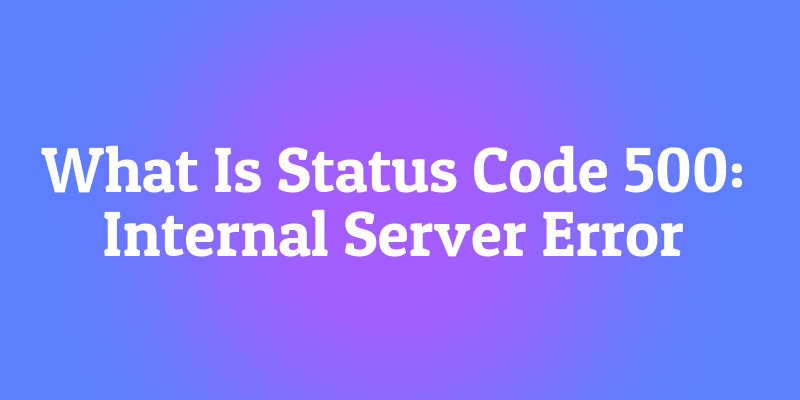You try to access a news article or a social media post, but instead of the content, you see a clear, unambiguous message: "This content is not available in your country due to legal restrictions." This isn't a technical error or a server problem it's a deliberate, legally-mandated block. And it's communicated using one of the most politically charged HTTP status codes: 451 Unavailable For Legal Reasons.
Named after Ray Bradbury's dystopian novel Fahrenheit 451 (where paper burns at 451 degrees), this status code does more than just indicate a blocked resource. It makes a statement. It transparently declares that access is being denied specifically because of legal demands, such as government censorship orders, copyright takedowns, or court injunctions.
It's the difference between a website mysteriously disappearing (which could be a technical glitch) and a website being openly removed (which is a matter of public record). The 451 code brings transparency to the often-opaque world of online censorship.
If you care about digital rights, free speech, or simply understanding why certain content vanishes from the internet, the 451 status code tells a important story.
If you're building applications that need to handle complex content delivery scenarios, you need a tool that can help you test various response codes. Download Apidog for free; it's an all-in-one API platform that allows you to simulate different server responses, helping you ensure your applications handle everything from successful requests to legally-restricted content.
Now, let's explore the fascinating story behind HTTP status code 451.
The Problem: Opaque Censorship
Before 451 existed, when content was removed for legal reasons, it was often handled in ways that obscured what was really happening:
- Returning a generic
404 Not Found, making it look like the content never existed - Using
403 Forbidden, which doesn't explain why access is denied - Simply redirecting to a homepage or error page with no explanation
This lack of transparency made it difficult to distinguish between technical failures and deliberate censorship. The 451 status code was proposed to solve this problem by creating a standard way to communicate legal takedowns openly.
What Does HTTP 451 Unavailable For Legal Reasons Actually Mean?
The 451 status code indicates that the server is denying access to the resource as a consequence of a legal demand. The server operator has received a legal demand to block access, and they're choosing to be transparent about it.
The official RFC (7725) that defines this status code states:
This status code indicates that the server is subject to legal restrictions which prevent it from servicing the request and that the server is unwilling to disclose the precise reason for the refusal.
A proper 451 response should include details in the response body explaining the nature of the legal restriction. It might also include a Link header pointing to more information.
A typical 451 response looks like this:
HTTP/1.1 451 Unavailable For Legal ReasonsContent-Type: text/htmlLink: <https://example.com/legal/blocking-notice>; rel="blocked-by"
<html><head><title>451 Unavailable For Legal Reasons</title></head><body><h1>451 Unavailable For Legal Reasons</h1><p>This content is not available in your country due to a copyright infringement claim.</p><p>Case Reference: DMCA-2023-12345</p><p>For more information, visit our <a href="/legal/blocking-notice">legal transparency page</a>.</p></body></html>
In simpler terms, 451 means the content you're trying to view can’t be accessed because of laws or court orders. For instance, a website page may be blocked in your country because it violates copyright laws or government censorship rules.
The Origin and Significance of Status Code 451
The number 451 was chosen deliberately; it’s a nod to Ray Bradbury’s dystopian novel Fahrenheit 451, where books are banned and burned. The authors of the status code intended to highlight censorship and the suppression of information.
Unlike generic error codes, 451 specifically signals that the denial of access is legally motivated, not because the page is broken or missing.
The Literary Connection: Why 451?
The number 451 wasn't chosen randomly. It's a direct reference to Ray Bradbury's 1953 science fiction novel Fahrenheit 451, which depicts a future society where books are banned and "firemen" burn any that are found. The title refers to the temperature at which paper burns.
The choice of 451 for this status code is deeply symbolic:
- It acknowledges the reality of censorship
- It pays homage to a classic work about the dangers of censorship
- It makes the technical standard more memorable and meaningful
- It serves as a conversation starter about digital rights
As the RFC itself notes: "The use of this error code provides a more honest and transparent representation of the situation than simply returning a 404 or 403."
When and Why Is a 451 Status Code Used?
Websites or servers return 451 in scenarios such as:
- Government blocking access to certain web pages due to controversial or illegal content.
- Copyright infringement claims forcing removal of specific material.
- Court orders requiring ISPs or hosting companies to prevent access to certain domains or resources.
- Geographic restrictions due to local laws affecting content availability.
For example, if a news article is banned in a particular region due to local laws, trying to access it from there might show a 451 status code instead of a generic blocked message.
Common Scenarios That Trigger 451 Responses
1. Government Censorship and Geo-blocking
This is the most politically significant use case. Governments may order ISPs or content platforms to block access to certain content within their jurisdiction.
- Social media platforms blocked during political protests
- News websites restricted in certain countries
- Messaging apps banned by authoritarian regimes
2. Copyright and DMCA Takedowns
Under laws like the Digital Millennium Copyright Act (DMCA) in the United States, copyright holders can request that infringing content be removed. Some services use 451 to transparently indicate these takedowns.
3. Court Orders and Injunctions
Courts may order specific content to be blocked, such as:
- Content that violates someone's privacy rights
- Material subject to ongoing legal proceedings
- Information that could compromise national security
4. Corporate Policy Enforcement
While less common, some organizations might use 451 internally to indicate content blocked due to legal or compliance policies.
How Does 451 Affect Internet Users and Website Owners?
For users, seeing a 451 status code signals that content is unavailable, but importantly, it clarifies that the cause is legal, not technical. This transparency helps users understand that censorship or legal regulation is at play, which can foster awareness and discussions about internet freedom.
Website owners, on the other hand, might use the 451 response to comply with legal mandates while still providing clear communication about restrictions. It helps maintain transparency and can protect them from legal penalties.
451 vs. Other Client Errors: Knowing the Difference
It's important to distinguish 451 from other 4xx status codes:
451vs.403 Forbidden:
403means "I won't let you access this" (usually for permission/authentication reasons)451means "I would let you access this, but the law won't let me"
2. 451 vs. 404 Not Found:
404means "I looked and couldn't find it" (the resource may or may not exist)451means "I know exactly where it is, but I can't show it to you for legal reasons"
3. 451 vs. 410 Gone:
410means "This content was intentionally removed and won't come back"451means "This content still exists but is legally blocked from your access"
The Transparency Advantage
The 451 status code serves several important purposes beyond just indicating unavailability:
- Accountability: It makes censorship visible and measurable. Researchers can track how often and where
451responses occur. - User Clarity: Users understand why they can't access content, reducing frustration and confusion.
- Legal Record: It creates a technical paper trail of censorship actions.
- Public Awareness: It raises awareness about internet censorship patterns.
Testing 451 Responses with Apidog
While you might not be implementing censorship in your applications, testing how your software handles various error responses is crucial for robustness. Apidog is perfect for this kind of testing.
With Apidog, you can:
- Mock 451 Responses: Configure mock endpoints that return
451status codes with different response bodies, simulating various legal restriction scenarios. - Test Client Handling: Ensure your applications or APIs correctly interpret
451responses and display appropriate messages to users. - Compare Error Handling: Test how your application handles
451versus403,404, and other error codes to ensure each gets the proper user-facing treatment. - Document Legal Compliance: If you're building a platform that might need to implement legal blocks, use Apidog to document the expected
451response format for your API. - Internationalization Testing: Test how your application handles
451responses in different languages and regions, since legal restrictions often vary by jurisdiction.
Real-World Examples and Controversies
The 451 status code has been adopted by several major platforms:
- Twitter: Has used
451when complying with country-specific content removal requests - Google: Sometimes uses
451in search results when content is legally restricted - GitHub: Has implemented
451for content removed due to DMCA takedowns - The Guardian: The British newspaper used
451when covering censorship stories
However, the code isn't without controversy. Some critics argue:
- It might normalize censorship by making it a standard technical practice
- Companies might use it too broadly for various types of content removal
- It doesn't actually prevent censorship it just makes it more visible
Best Practices for Implementing 451
If you're considering implementing 451 responses in your service:
- Be Specific: Include clear details in the response body about why the content is blocked and under what legal authority.
- Provide Appeal Mechanisms: Include information about how users can appeal the blocking or learn more about the legal demand.
- Maintain Transparency Reports: Many companies that use
451also publish regular transparency reports detailing the number and nature of content removal requests they receive. - Use It Appropriately: Reserve
451for genuine legal demands, not for routine content moderation or terms of service violations.
The Ethical and Technical Challenges of Status Code 451
While 451 promotes transparency, it also sparks debates:
- Should governments have the power to restrict internet content?
- How do organizations balance legal compliance with user rights?
- Is there room for user appeals or transparency reports?
Technically, implementing 451 means accurately detecting when legal restrictions apply and effectively communicating them without disrupting overall user experience.
The Future of Digital Rights and Transparency
The 451 status code represents a small but significant step toward greater transparency in internet governance. As more platforms adopt it, we get a clearer picture of how and where online censorship occurs.
For developers and internet users, understanding 451 means understanding that sometimes, the barriers to information aren't technical they're legal and political. The code serves as a reminder that the open internet we often take for granted exists within a framework of laws and regulations that vary widely around the world.
Conclusion: More Than Just an Error Code
The HTTP 451 Unavailable For Legal Reasons status code is unique in the HTTP specification. It's not just a technical standard; it's a political statement, a literary reference, and a tool for transparency in an increasingly regulated digital world.
While we might wish that censorship didn't exist, the 451 code at least ensures that when it does happen, it doesn't happen in the shadows. It brings the reality of legal restrictions into the light, allowing for accountability, research, and public awareness.
Understanding status code 451 is vital in today's internet landscape where legal controls affect accessibility. Recognizing when a site is unavailable due to legal reasons helps users grasp the bigger picture behind online content restrictions.
For developers building the next generation of web applications, understanding status codes like 451 is part of building robust, transparent systems that can navigate the complex intersection of technology, law, and human rights. And when you need to test how your applications handle these complex scenarios, a comprehensive tool like Apidog provides the platform you need to ensure your software is prepared for the real-world challenges of content delivery in a regulated internet.



